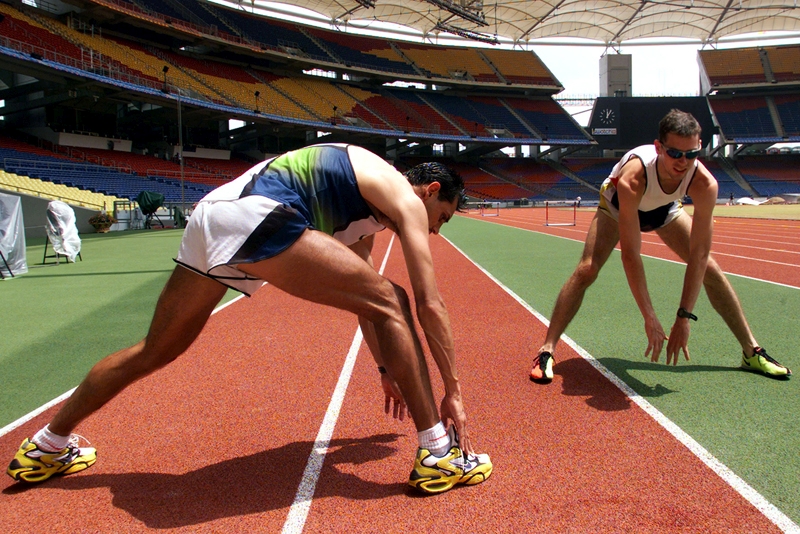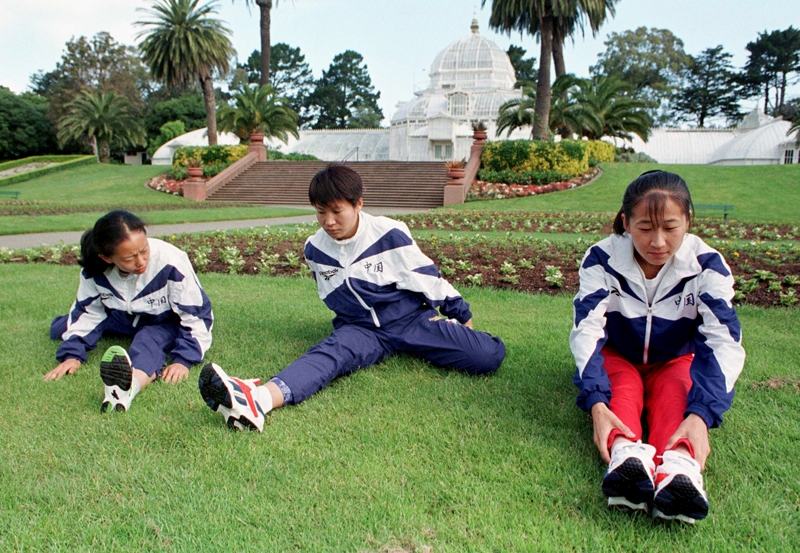You are viewing 1 of your 1 free articles. For unlimited access take a risk-free trial
Running flexibility: using foam for fascial release

New research suggests that foam rolling can improve flexibility and range of motion in runners by releasing tissue stiffness and tension
It’s well known that distance runners subject their muscles, tendon and ligaments to a high degree of impact loading. What is less appreciated however is that the myofascial tissue (a type of thin, strong, fibrous connective tissue that extends throughout the body to provide support and protection to muscles and bones) of the skeletal system is also liable to take a hit, resulting in an accumulation of tension. This is especially true for the myofascial tissues of the hamstring muscles of the rear thigh, which are loaded heavily especially during the late swing phase (just before footstrike) of the running gait, resulting in excessive tension and reduction of hamstring flexibility.Flexibility requirements
Flexibility in the context of running may be defined as the property and ability of body tissues to achieve full range of motion (ROM) without any injury to the joints or within their groups, and research shows that maintaining proper muscle flexibility is crucial for long-distance runners(1). One technique to increase flexibility of the soft tissues is known as ‘myofascial release’ (MFR). MFR uses manual therapy to help reduce restrictions or adhesions within layers of the fascial tissue, and includes a number of techniques such as massage and trigger-point release. The downside for runners of limited means is that most of these techniques rely on a therapist to administer treatment, which involves time and money(2).The good news is that there are techniques where someone can apply myofascial release to themselves – so called self-myofascial release (SMFR). In contrast to those therapist-led techniques mentioned above, SMFR is performed independently using the person’s own body mass and special tools such as massage balls or foam rollers to apply pressure and stretch the restricted soft tissue(3). SMFR involves the subject moving back and forth over the ball/roller using their bodyweight to apply pressure, targeting the entire length of the muscle being released in both directions. The effectiveness of SMFR is most likely explained by sweeping and direct pressure on soft tissue, which causes warming of the fascia, pulling apart the fibrous adhesions and restrictions within layers of the fascia, and restoring soft tissue elasticity(4).
The role of rollers
The use of foam rolling (see this article for an in-depth discussion about the technique) has been investigated extensively as a technique for SMFR(5). However, despite the many studies on this topic, none of them involves the influence of SMFR on muscle flexibility in runners. If SMFR can improve running flexibility, this would be valuable to know. Myofascial tissue in the body works as a linked chain system; if one part of the chain is stiff or snagged with adhesions, overloading forces can be transferred along myofascial system to another part, leading to tissue overload, disruptions in functional movement patterns and repetitive strain injuries(6). However, brand new research by Polish scientists has just evaluated the effect of SMFR on muscle flexibility in long-distance runners, and has come up with some fascinating findings(7).New research
The study comprised of 62 long-distance, recreationally running participants (18 females and 44 males), aged 20–45 years who were running regularly at distances of between 30km to 100km per week (19 – 63 miles per week), and with no injury history in the six months prior to the study. The runners were randomized into two groups: a SMFR group using foam rolling (32 runners) and a control group (30 runners) who did no SMFR. Before testing, the SMFR participats were tutored on how to carry out the foam rolling to produce maximum myofascial release. This involved rolling along muscle fibers, with a constant pressure and speed of 2.5cms per second – but only on muscle tissue, and avoiding pressure on bones, joints or tendons. The muscle groups to which SMFR was applied were as follows:- Hamstrings
- Gluteus maximus (buttocks)
- Hip adductors Inner thighs)
- Quadriceps (frontal thighs)
- Tensor fasciae latae (outer thighs)
- Gastrocnemius (calf)
Figure 1: Hamstring rolling

Figure 2: Gastrocnemius rolling

Figure 3: Gluteus maximus rolling

Figure 4: Hip adductor rolling

Figure 5: Quadriceps rolling

Figure 6: Tensor fasciae latae rolling

For the actual test, both groups warmed up by running at their own comfortable pace for five minutes, after which muscle flexibility was assessed twice: immediately after the warm up and then again after 15 minutes. Following the first flexibility assessment, each participant in the SMFR group applied the self-myofascial release technique using foam rollers while the runners in the control group did not perform any SMFR techniques. Then after 15 minutes, both groups were reassessed for flexibility using the criteria set out by Chaitow(8).
What they found
The key finding was that the SMFR technique using a foam roller significantly improved muscle flexibility compared to no rolling. In the SMFR group, higher levels of flexibility were observed in the piriformis (external rotation muscles), adductor and tensor fasciae latae muscles. These flexibility gains were also accompanied by an increase in range of motion. The control group meanwhile experienced no such gains. Based on their results, the authors went onto recommend that self-myofascial release technique with foam rollers should be incorporated in the daily training routine of long-distance runners, as well as athletes of other sport disciplines seeking improved flexibility.Practical application
‘An ounce of prevention is worth a pound of cure’ as the saying goes. This is the first study on flexibility and SMFR and the results are extremely positive. Runners who often experience undue stiffness and tightness would seem to have much to gain by applying some regular SMFR using a foam roller. Foam rollers are cheap to purchase and can be used anytime, anywhere. Even better, the time investment is minimal. Runners who are pushed for time however may not have to foam roll religiously on a daily basis; SMFR carried out after harder or longer training sessions is still likely to deliver plenty of benefits. If this is something you’d like to try, a good starting point is to use the protocol outline above (six exercises) using a roller used constructed of high-density foam (ie quite stiff) with a rolling diameter of around 14cms. If you are new to the technique of foam rolling, this excellent guide in the form of a PDF by the Sports Medicine Institute International (smiweb.org/) makes for excellent reading!References
- J. Sports Med. 2002, 30, 199–203
- Bodyw. Mov. Ther. 2017, 21, 446–451
- Ther. Today 2004, 9, 48–49
- Strength Cond. Res. 2013, 27, 812–821
- Train. Sports Health Care 2014, 6, 189–196
- Orthop. Trauma Surg. Rel. Res. 2011, 5, 38–46
- J. Environ. Res. Public Health 2022, 19(1), 457
- Chaitow, L. Muscle Energy Techniques; Elsevier Health Sciences: London, UK, 2013
Newsletter Sign Up
Testimonials
Dr. Alexandra Fandetti-Robin, Back & Body Chiropractic
Elspeth Cowell MSCh DpodM SRCh HCPC reg
William Hunter, Nuffield Health
Newsletter Sign Up
Coaches Testimonials
Dr. Alexandra Fandetti-Robin, Back & Body Chiropractic
Elspeth Cowell MSCh DpodM SRCh HCPC reg
William Hunter, Nuffield Health
Keep up with latest sports science research and apply it to maximize performance
Today you have the chance to join a group of athletes, and sports coaches/trainers who all have something special in common...
They use the latest research to improve performance for themselves and their clients - both athletes and sports teams - with help from global specialists in the fields of sports science, sports medicine and sports psychology.
They do this by reading Sports Performance Bulletin, an easy-to-digest but serious-minded journal dedicated to high performance sports. SPB offers a wealth of information and insight into the latest research, in an easily-accessible and understood format, along with a wealth of practical recommendations.
*includes 3 coaching manuals
Get Inspired
All the latest techniques and approaches
Sports Performance Bulletin helps dedicated endurance athletes improve their performance. Sense-checking the latest sports science research, and sourcing evidence and case studies to support findings, Sports Performance Bulletin turns proven insights into easily digestible practical advice. Supporting athletes, coaches and professionals who wish to ensure their guidance and programmes are kept right up to date and based on credible science.











